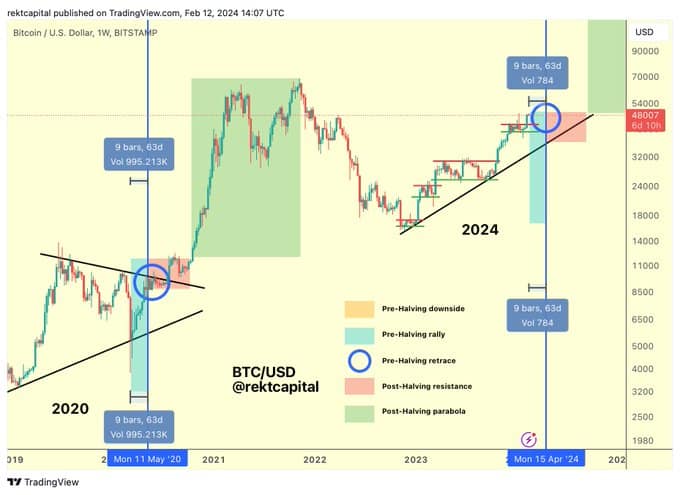Bitcoin halving is an event where miner rewards are split in half, and they receive half the number of bitcoins for verifying transactions. Halving takes place after every 210,000 blocks or every four years until bitcoins’ total supply of 21 million is reached. Halvings are important for investors because they reduce the rate at which new bitcoins are created. This potentially raises bitcoin prices if demand remains stable.
The next halving is expected in April 2024, around when the network hits 740,000 blocks. At that time, the block reward will decrease from 6.25 to 3.125 bitcoins. The exact date is uncertain due to the variable time it takes to generate new blocks on the network. Let’s delve into the five phases highlighted by Rekt Capital, providing insights for traders and enthusiasts alike.


5 Phases of Bitcoin Halving Explained
The Pre-Halving Downside phase refers to a period before the Bitcoin halving event where the cryptocurrency experiences downward price movements or corrections. This phase is marked by a decrease in Bitcoin Price as traders anticipate the upcoming halving event. However, this phase has concluded, as indicated by the recent Weekly Candle Close, suggesting that the downward trend has ended. The transition into the Pre-Halving Rally phase signifies a shift in market sentiment, with Bitcoin poised for potential upward momentum leading up to the halving event.
The Pre-Halving Rally phase typically occurs approximately 60 days before the Bitcoin Halving event, which is expected in April 2024. During this phase, there is a surge in Bitcoin’s price as investors anticipate the halving event. This rally is often fueled by hype surrounding the event, with investors buying into the excitement. Short-term traders and speculators aim to profit from this hype-driven rally by purchasing Bitcoin before the halving and selling shortly after, a strategy known as “Buy the Hype, Sell the News.” This behavior contributes to a Pre-Halving retrace, where Bitcoin experiences a temporary dip in price leading up to the halving event itself.
Following the conclusion of the Pre-Halving Rally, the Pre-Halving Retrace phase typically unfolds a couple of weeks before the actual Halving event. During this phase, Bitcoin experiences a temporary price decline, represented by a dark blue circle on the charts. Historical data shows that in 2016, this retracement was as deep as -38%, while in 2020, it was -20%. This retracement phase can last for several weeks, leading investors to question whether the Halving event will indeed have a positive impact on Bitcoin’s price.
After the Pre-Halving retrace, Bitcoin enters a phase known as Re-Accumulation, characterized by an extended period of stability or leveling off (consolidation) and sideways movement, demonstrated in red on the charts. This phase can extend up to 150 days, roughly five months. During this time, many investors may feel disillusioned due to the lack of significant price movements following the Halving event. Feelings of boredom, impatience, and disappointment may lead some investors to exit their positions prematurely.
After the consolidation period, Bitcoin enters a phase of rapid growth known as the Parabolic Uptrend. This phase is marked by a breakout from the previous sideways movement into a strong upward direction, symbolized by green on the charts. During this phase, Bitcoin’s price rises sharply, reaching new record highs. Investors experience a surge of excitement and optimism as Bitcoin’s value climbs rapidly, reflecting a strong bullish sentiment in the market.
The five phases of Bitcoin halving offer valuable insights into the cryptocurrency’s market dynamics leading up to this pivotal event. From anticipation and hype-driven rallies to temporary retracements and periods of stability, each phase plays a crucial role in shaping Bitcoin’s trajectory. As we approach the next halving in April 2024, traders and enthusiasts alike can use these phases to better understand market behavior and navigate the ever-evolving landscape of digital assets. With Bitcoin’s future remaining uncertain yet promising, staying informed about these phases can be key to making informed investment decisions in the dynamic world of cryptocurrency.
Top Presale
Best Cloud Mining
Top Exchanges
The presented content may include the personal opinion of the author and is subject to market condition. Do your market research before investing in cryptocurrencies. The author or the publication does not hold any responsibility for your personal financial loss.
CoinGape prepared a review methodology to rate crypto exchanges, tools, and apps. We curated a list of metrics to evaluate crypto platforms based on their services, user experience, security and customer support, payment gateways and charges, pricing and promotions. Visit our Review Methodology page to learn more about how we review each crypto platform.
This content is purely for educational purposes and should not be considered as financial advice. Do your own research before investing in any crypto platform and only invest the amount you can afford to lose.
DAILY NEWSLETTER
Your daily dose of Crypto news, Prices & other updates..
Source: https://coingape.com/blog/phases-of-bitcoin-halving/